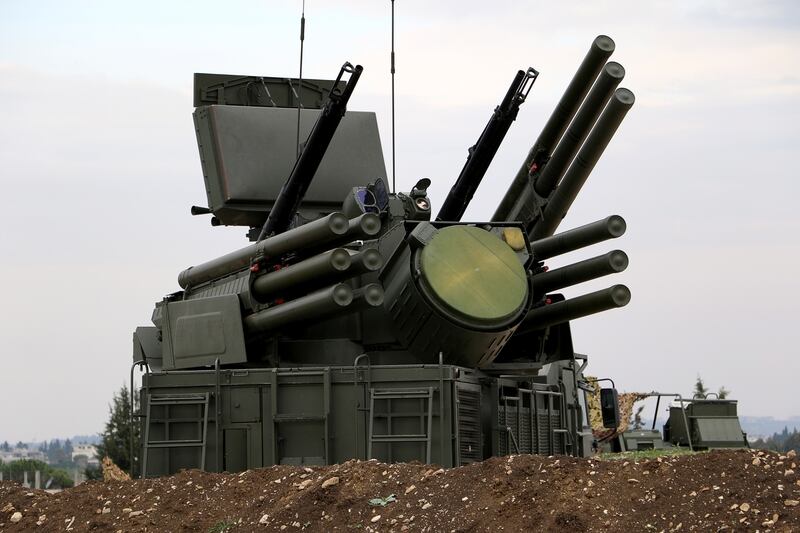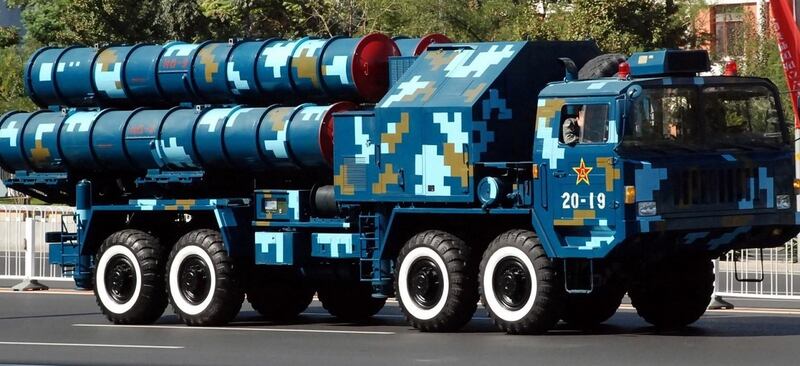Nope, you are assuming that Chinese radar technology is advanced, when it is crap, and can be jammed/disabled. No point in discussing scenarios that sound like a Chinese fanboy's dream. It's simple: If you can disable the Chinese radars, they cannot track your supersonic Brahmos missile coming in at low altitude at supersonic speeds maneuvering at 12 g in terminal mode.
Here’s how improving enemy anti-aircraft threats put pilots and crews at risk
Kyle Rempfer
May 6, 2019
A Russian S-400 air defense missile system rolls through Red Square in Moscow in May 2017. (Ivan Sekretarev/AP)
The days of sequential air campaigns may be gone.
No longer will the U.S. Air Force plan to roll over an enemy air defense network in a matter of days, then pepper the battlefield with close-air support as ground units trample through ill-equipped armies with legacy weapons systems.
Instead, the service should be prepared to provide close-air support on Day One of the campaign, and be prepared for hideaway
surface-to-air missiles,
anti-aircraft artillery,
man-portable air defense systems and more that will be rolled out even beyond Day 20 of this hypothetical fight.
“
This is going to be a formidable threat throughout the conflict. It’s not going to be quick; it’s going to take time,” said Mark Gunzinger, a senior fellow at the Center for Strategic and Budgetary Assessments and a former deputy assistant secretary of defense.
“If Russia invaded Poland or the Baltic states, we’re not going to have the luxury of knocking down Russian air defenses before providing close-air support," he added. "On Day One, we’re going to need to conduct close-air support.”
That’s just one of the challenges in the contested airspace of the future, and it’s a threat the Air Force agrees must be addressed, as it has been lobbying Congress for
74 more squadrons to prepare for war against major powers.
It’s also a capability gap that adversaries understand. Growth of American air power has remained relatively static since the end of the Cold War, as budgetary constrictions chipped away at the fleet. There is a reason why Russia and China have laid out lethal air defense networks, explored new forms of electronic warfare, and are developing fifth-generation stealth fighters, according to a
congressionally mandated study by the CSBA.
Bolstering AAA guns
Anti-aircraft artillery, or AAA, could pose a crippling threat to aircraft that fly low and slow, such as those providing close-air support.
If certain key developments are made — including rail guns and extended-range artillery — “virtually no altitude will be safe,” according to David Sobota, a weapons expert at Air Force Research Laboratory, based at Wright-Patterson Air Force Base, Ohio.
Previously, AAA guns were manually loaded — cranked by hand — by crews of six to 10, Sobota said. They only had mechanical crosshairs with which to aim.
But today, AAA can be linked to a web of integrated air defense systems. They are often used to protect surface-to-air missile sites and other high-value ground targets. Modern AAA also have electro-optical and infrared sensors as well as radars that allow the operator to know how much to lead the target.
“Modern systems are totally automated with auto-slewing and usually have a crew of just two. These are far more mobile and are much faster to set up,” Sobota said.
“
Tracking has improved tremendously over the years, so we’re seeing huge improvements in lethality of weapons systems due to more sophisticated tracking algorithms and increased computational power."
Sobota and his colleague, Air Force Capt. Yongjun Yoon, are part of the Air Force Research Lab’s Sensors Directorate, where they’re working on ways to detect highly mobile ground threats such as modern AAA guns.
“AFRL has kicked off an effort to research technology that will enable any aircraft with a current weather radar — if possible — flying in a hostile territory to detect the presence of a AAA gun at a safe standoff range before the guns engage," Sobota said.
A Russian Pantsir-S1 anti-aircraft defense system guards the Russian Hmeimim military base in Latakia province in northwest Syria in December 2015. (Paul Gypteau/AFP via Getty Images).
The Air Force has programs that try to detect anti-aircraft guns as they fire. The programs detect shells, bullets and muzzle flashes, but “if you’re on an approach landing, taking off at minimum airspeed or at low altitude, that is too late," Sobota said. “You won’t be able to make an evasive maneuver.”
“In the future, AAA would be the primary threat against the Air Force’s swarming UAV strategy since low altitude is required to get the needed resolution to detect ground threats,” he added.
A Chinese HQ-9 air defense system is exhibited during China’s 60th anniversary parade in Beijing in 2009. (Jian King via Wikipedia)
Drones are relatively cheap. That makes an enemy’s multimillion-dollar surface-to-air missile or $250,000 infrared missile not so cost-effective against a drone swarm, Sobota said.
AAA guns pose a unique challenge, said Douglas Birkey, executive director for the Mitchell Institute for Aerospace Power Studies.
“A B-1 has the ability to release about a hundred small-diameter bombs all at once,” Birkey said. “Think about what that could do to surface-to-air missile systems. You could trigger the launch of a ton of them, really put the enemy into a cost-imposing strategy pretty fast. Against AAA, that is a harder problem set.”
Missiles and emissions
The technology for man-portable air-defense systems and AAA is rapidly improving.
But Gunzinger is more concerned about advanced surface-to-air missiles with active or passive sensors that cover large areas.
Russia, for instance, has an integrated air defense network that covers much of the Baltic and Black Sea regions. Similarly, China has extended its air defense reach into the South China Sea.
Surface-to-air missiles remain a major challenge in Europe for future NATO air operations, Gunzinger said.
In the Pacific, it’s a combination of surface-to-air missiles and emerging fifth-generation aircraft capabilities coupled with long-range air-to-air weapons.
AAA would remain a challenge at low altitudes for close-air support, but the future battlespace may also include attacks along the electromagnetic spectrum, which could pose just as much a challenge to
joint terminal attack controllers and other forward air controllers.
“In the future, our war fighters are going to have to pay attention to what they emit,” Gunzinger said. “Every bit of energy they emit in the way of communications, radar energy, even high-powered jamming and so forth will probably be detected and used to locate [them].
“Russia has done that in Ukraine, where their ground units are trained to detect communication emissions on the part of the Ukrainian forces and use that to queue fires."
Using a sensor that emits in order to detect AAA guns could also increase the risk of attack, even if that sensor is strapped to an aircraft from a long distance, according to Gunzinger.
“
Aircraft doing that could be saving themselves from AAA, but they could be highlighting themselves to another threat — an airborne threat, a surface-to-air battery or whatever,” he said.
The battlespace of the future isn’t going to be one-off, geographically isolated AAA and surface-to-air missile sites, he noted. “It’s going to be dense; it’s going to be integrated. ...
It’s going to have active and passive sensors. It’s going to range across the electromagnetic spectrum.”
Structural and manning problems
And it’s probably going to impose a high attrition rate on aircraft and aircrew, because past defense budgets mostly stopped factoring attrition and loss of aircraft into force-structure plans.
“The current fleets are so small, they don’t realistically include attrition,” Birkey said.
Except for a small number of stealth F-22s, B-2s and F-35As that are now part of the force, the Air Force’s combat fleet cannot operate in contested environments without the risk of suffering significant attrition, according to the Center for Strategic and Budgetary Assessments study.
The Air Force’s non-stealth bombers, fourth-generation fighters, aerial-refueling tankers, battle-management aircraft and drone platforms are not well-suited for contested environments, according to the study. That doesn’t only mean a loss of aircraft in a potential fight over Russian or Chinese skies — it would impact pilots, too.
“Obviously we have a pilot crisis in peacetime. In wartime, they would be beyond crippled,” Birkey said. “Even if you wanted to surge it upwards, it’s a huge problem. The pilot training bases are currently maxed out. You can’t get the infrastructure back that you shuttered.”
The manufacturing base for a lot aircraft and ammunition requires similar investment costs that make restarting an industrial endeavor so difficult, Birkey said.
The complacency issue stemmed in large part from a post-Cold War drawdown, “an Air Force procurement holiday that extended from the 1990s well through the turn of the century,” according to a
Mitchell Institute study issued in March.
Complacency also comes from how air wars have been fought for nearly two decades. While American forces are replete with combat experience, much of that deals with counterinsurgency and permissive environments.
Some aircrews have dealt with legacy AAA guns in Syria and air defense systems in Libya, but those systems are archaic compared to what China or Russia could field.
Especially in Syria, where Russian air defense systems are present, fifth-generation fighters have played a key role in blocking potential threats, according to some observers.
“The reason why you saw F-22s there for so long, and F-35s back now, is because it’s really a deterrence factor,” Birkey said. “The only way you can operate fourth-generation assets there is by having these fifth-generation aircraft in theater. It’s signaling to the Syrians and the Russians that they should not attack our assets because if they do we have very survivable options for the fifth-generation to strike back."
That highlights the importance of fifth-generation aircraft going up against future air defense threats, he said.
Air defense is just getting started
The technology that buoys air defense is rapidly growing. For example, AAA guns are far more threatening at lower altitudes, between 10,000-15,000 feet. Legacy AAA guns are still lethal to 40,000 feet, and they will become more lethal as radar and electro-optical tracking improves with computational trends, Sobota said.
China is working on a new stealth fighter-bomber, perhaps to be named the H-20. This concept art popped up on Chinese social media in February.
Modern propellants are boosting the range of gun systems. The U.S. Army recently doubled the range of its howitzer with new propellants, for instance. Longer-range, rocket-assisted artillery will become widespread, Sobota noted, and “smart shells,” utilizing sensor-guided sub-munitions, are also becoming more common.
“
In the more distance future, AAA systems will become more lethal at much higher attitudes (60,000-plus feet) as numerous new technologies such as rail guns, extended-range artillery and ‘smart’ artillery shells come online,” Sobota said.
“Should AAA include rail guns and extended-range artillery, virtually no altitude will be safe."
The hypothetical system is typically envisioned as a game-changer for naval warfare, where it may be able to sink warships and aircraft carriers from massive distances. But the Air Force should be paying attention as well, according to Sobota.
https://www.airforcetimes.com/news/...ircraft-threats-put-pilots-and-crews-at-risk/
Read the above article.
View attachment 64858
View attachment 64859
View attachment 64860
View attachment 64861




 i am no expert but the idea that an IAF aircraft would fly over 1000 km over chinese mainland without being intercepted is nonsense.
i am no expert but the idea that an IAF aircraft would fly over 1000 km over chinese mainland without being intercepted is nonsense.